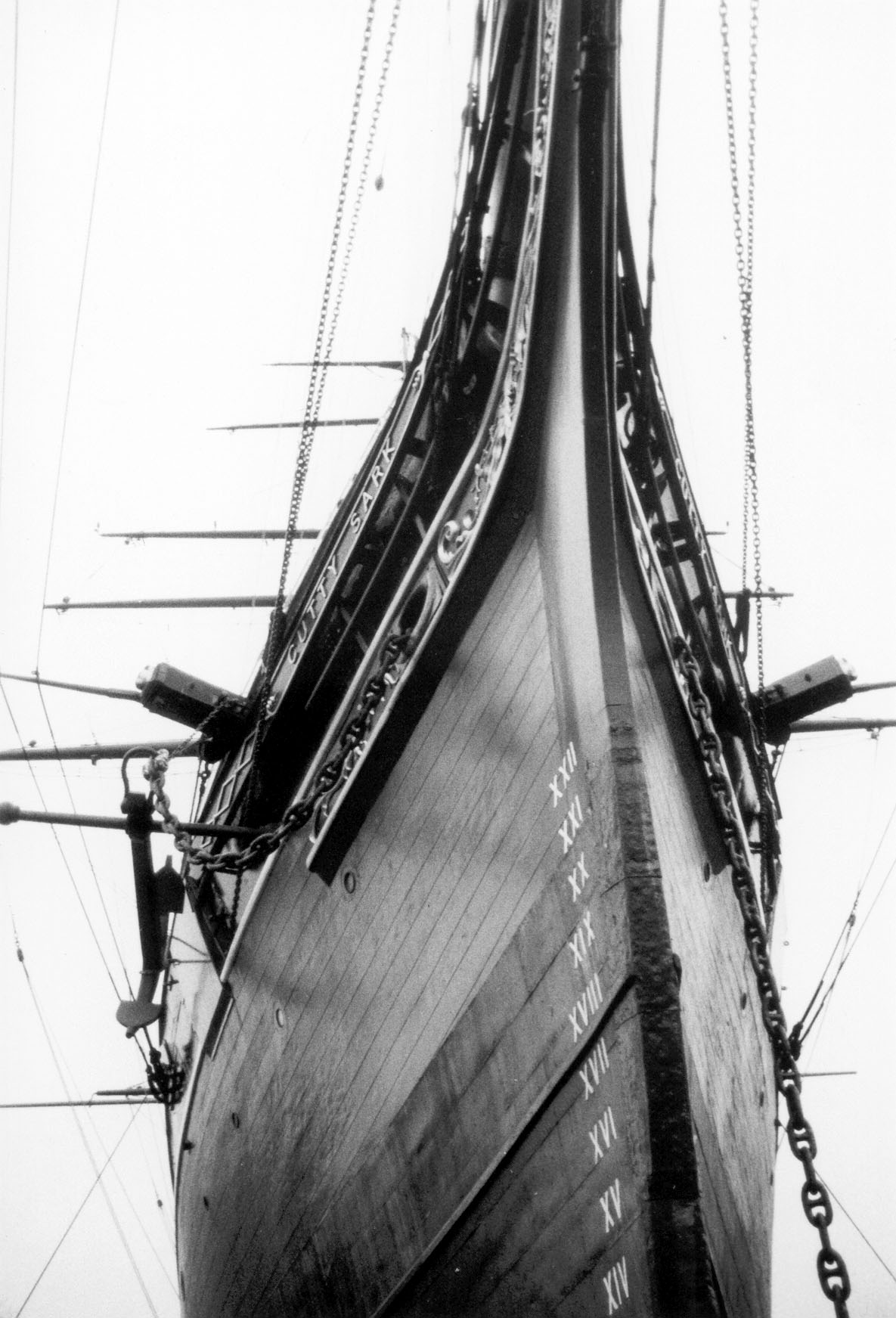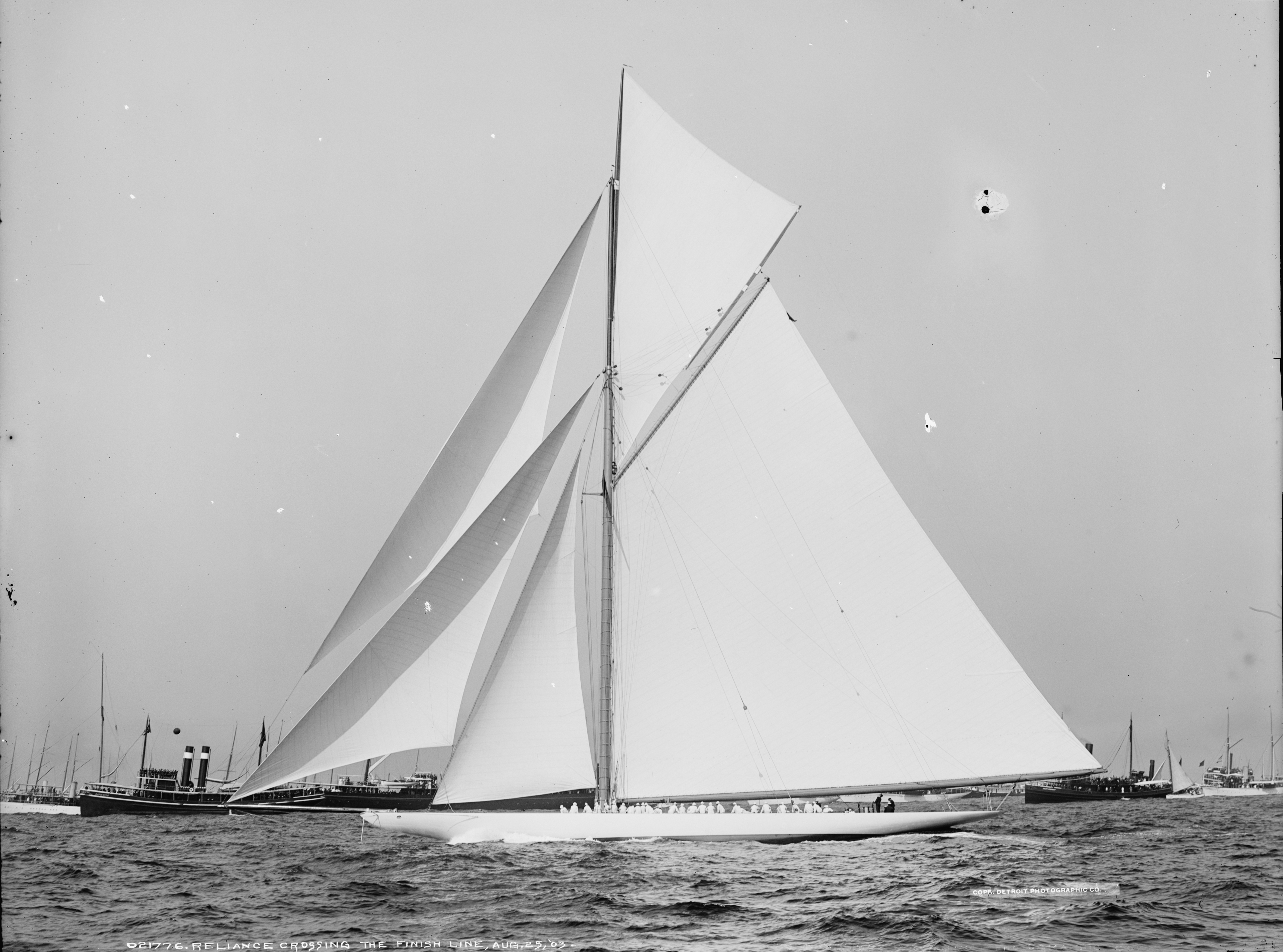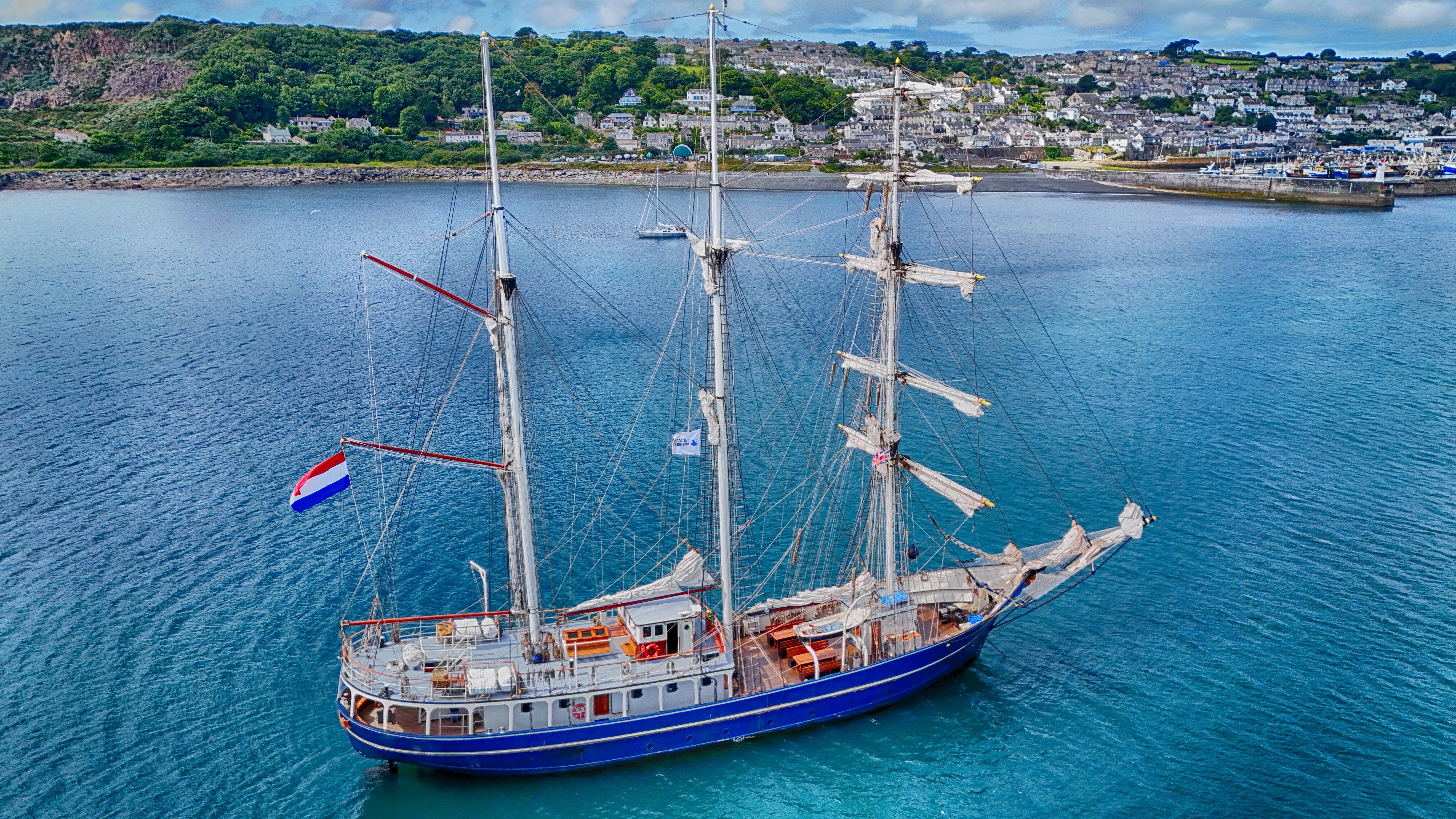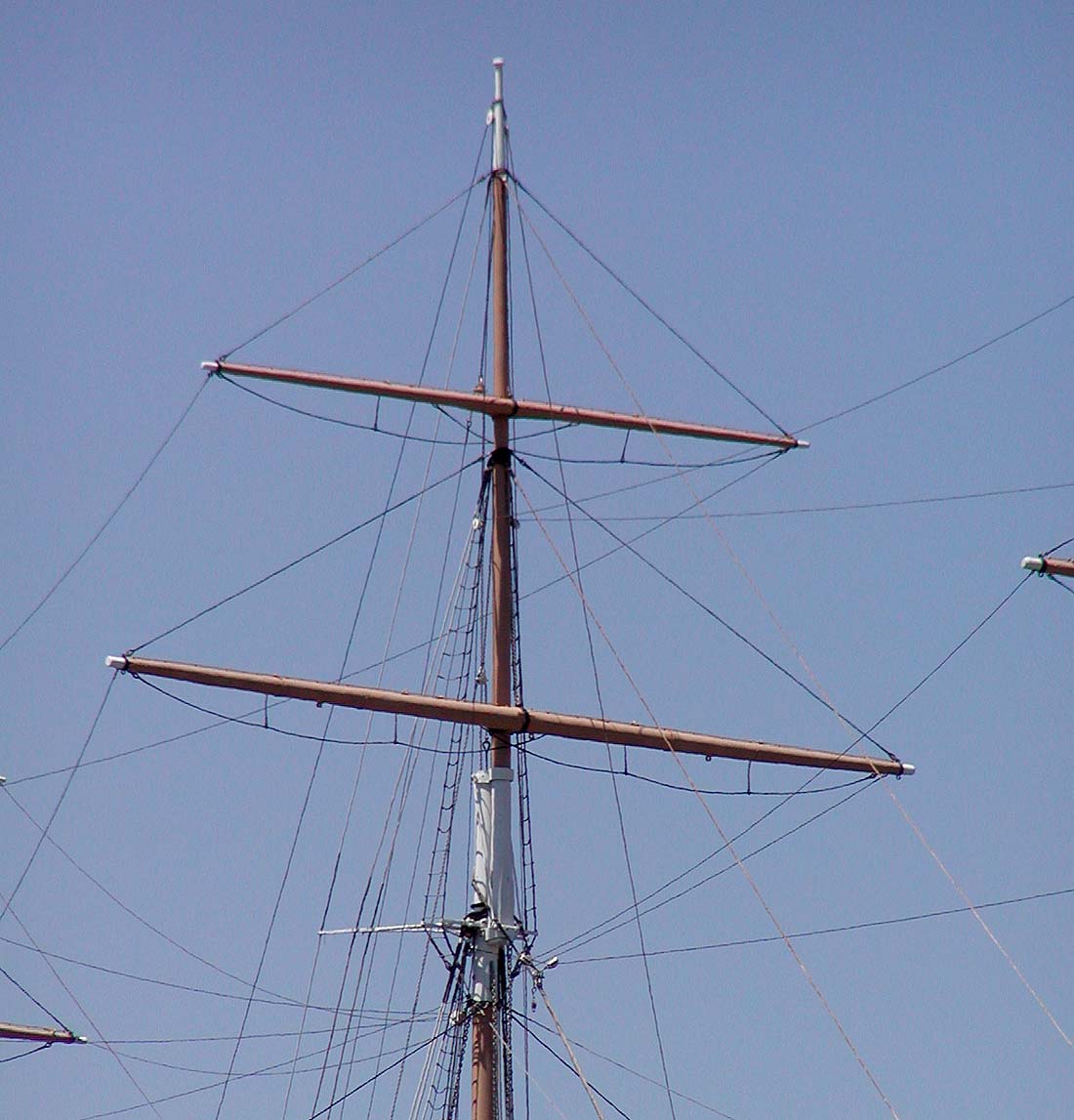|
Topsail
A topsail ("tops'l") is a sail set above another sail; on square-rigged vessels further sails may be set above topsails. Square rig On a square rigged vessel, a topsail is a typically trapezoidal shaped sail rigged above the course sail and below the topgallant sail where carried, on any mast (i.e., a fully rigged ship would have a foremast topsail, a mainmast topsail, and a mizzen topsail). A full rigged ship will have either single or double (i.e., "split" upper and lower) topsails on all masts, the single or lower topsail being the second sail above the deck and the upper topsail where so rigged being the third. Although described as a "square" sail, a topsail on a full rigged ship refers not to the sail's shape but to it and its yard being rigged square (i.e., at a right angle) to the vessel's keel rather than in line with it (in which case it would be called a fore-and-aft rig or a fore-and-aft rigged sail) ; a square rigged topsail is nearly always trapezoidal in sha ... [...More Info...] [...Related Items...] OR: [Wikipedia] [Google] [Baidu] |
Cutty Sark
''Cutty Sark'' is a British clipper ship. Built on the River Leven, Dumbarton, Scotland in 1869 for the Jock Willis Shipping Line, she was one of the last tea clippers to be built and one of the fastest, at the end of a long period of design development for this type of vessel, which ended as steamships took over their routes. She was named after the short shirt of the fictional witch in Robert Burns' poem ''Tam o' Shanter'', first published in 1791. After the big improvement in the fuel efficiency of steamships in 1866, the opening of the Suez Canal in 1869 gave them a shorter route to China, so ''Cutty Sark'' spent only a few years on the tea trade before turning to the trade in wool from Australia, where she held the record time to Britain for ten years. Continuing improvements in steam technology early in the 1880s meant that steamships also came to dominate the longer sailing route to Australia, and the ship was sold to the Portuguese company Ferreira and Co. in 1895 ... [...More Info...] [...Related Items...] OR: [Wikipedia] [Google] [Baidu] |
Topsail Schooner
A schooner ( ) is a type of sailing vessel defined by its rig: fore-and-aft rigged on all of two or more masts and, in the case of a two-masted schooner, the foremast generally being shorter than the mainmast. A common variant, the topsail schooner also has a square topsail on the foremast, to which may be added a topgallant. Differing definitions leave uncertain whether the addition of a fore course would make such a vessel a brigantine. Many schooners are gaff-rigged, but other examples include Bermuda rig and the staysail schooner. Etymology The term "schooner" first appeared in eastern North America in the early 1700s. The term may be related to a Scots word meaning to skip over water, or to skip stones. History The exact origins of schooner rigged vessels are obscure, but by early 17th century they appear in paintings by Dutch marine artists. The earliest known illustration of a schooner depicts a yacht owned by the mayors (Dutch: burgemeesters) of Amsterdam, ... [...More Info...] [...Related Items...] OR: [Wikipedia] [Google] [Baidu] |
Topgallant Sail
On a square rigged sailing vessel, a topgallant sail (topgallant alone pronounced "t'gallant", topgallant sail pronounced "t'garns'l",C.S. Forester, ''Beat to Quarters'', Chapter VI. is the square-rigged sail or sails immediately above the topsail or topsails. It is also known as a gallant or garrant sail. Later full-rigged ships split the topsail (and often the topgallant sail) for easier handling. They thus set two topsails (and possibly two topgallant sails) per mast. The lower topgallant sail is immediately above the upper topsail. The upper or only topgallant sail is set from the top of the topgallant mast. If there is a lower topgallant it is set from midway down the topgallant mast. A staysail A staysail ("stays'l") is a fore-and-aft rigged sail whose luff can be affixed to a stay running forward (and most often but not always downwards) from a mast to the deck, the bowsprit, or to another mast. Description Most staysails a ... set on a stay running forward ... [...More Info...] [...Related Items...] OR: [Wikipedia] [Google] [Baidu] |
Topmast
The masts of traditional sailing ships were not single spars, but were constructed of separate sections or masts, each with its own rigging. The topmast is one of these. The topmast is semi-permanently attached to the upper front of the lower mast, at the top. Its shrouds run to the edges of the top, rather than to the sides of the hull, though long shrouds leading well aft to the hull, more in the manner of backstays, are sometimes seen. In accordance with the standard square rig sail plan, the topmast carries the topsail. In the late 19th century, however, topsails became so big that merchant ships began to divide them into two separate sails for easier handling; since these were still on the topmast they were known as upper and lower topsails to preserve the consistency of the naming scheme. The majority of large square-riggers today carry separate upper and lower topsails. The main topmast carries the upper end of the main-topmast-staysail; a mizzen-topmast may carry th ... [...More Info...] [...Related Items...] OR: [Wikipedia] [Google] [Baidu] |
Gaff Rig
Gaff rig is a sailing rig (configuration of sails, mast and stays) in which the sail is four-cornered, fore-and-aft rigged, controlled at its peak and, usually, its entire head by a spar (pole) called the ''gaff''. Because of the size and shape of the sail, a gaff rig will have running backstays rather than permanent backstays. The gaff enables a fore-and-aft sail to be four sided, rather than triangular. A gaff rig typically carries 25 percent more sail than an equivalent Bermuda rig for a given hull design. A sail hoisted from a gaff is called a gaff-rigged sail. Description Gaff rig remains the most popular fore-aft rig for schooner and barquentine mainsails and other course sails, and spanker sails on a square rigged vessel are always gaff rigged. On other rigs, particularly the sloop, ketch and yawl, gaff rigged sails were once common but have now been largely replaced by the Bermuda rig sail, which, in addition to being simpler than the gaff rig, usually all ... [...More Info...] [...Related Items...] OR: [Wikipedia] [Google] [Baidu] |
Tall Ship
A tall ship is a large, traditionally-rigging, rigged sailing vessel. Popular modern tall ship rigs include topsail schooners, brigantines, brigs and barques. "Tall ship" can also be defined more specifically by an organization, such as for a race or festival. History Traditional rigging may include square rigs and gaff rigs, usually with separate Mast (sailing), topmasts and topsails. It is generally more complex than modern rigging, which utilizes newer materials such as aluminum and steel to construct taller, lightweight masts with fewer, more versatile sails. Most smaller, modern vessels use the Bermuda rig. Author and master mariner Joseph Conrad (who spent 1874 to 1894 at sea in tall ships and was quite particular about naval terminology) used the term "tall ship" in his works; for example, in ''The Mirror of the Sea'' in 1906. Henry David Thoreau also references the term "tall ship" in his first work, ''A Week on the Concord and Merrimack Rivers'', quoting "Down o ... [...More Info...] [...Related Items...] OR: [Wikipedia] [Google] [Baidu] |
Yard (sailing)
A yard is a spar (sailing), spar on a mast (sailing), mast from which sails are set. It may be constructed of timber or steel or from more modern materials such as aluminium or carbon fibre. Although some types of fore and aft rigs have yards, the term is usually used to describe the horizontal spars used on square rigged sails. In addition, for some decades after square sails were generally dispensed with, some yards were retained for deploying wireless (radio) aerials and signal flags. Parts of the yard ; Bunt : The short section of the yard between the ''slings'' that attach it to the mast. ; Quarters : The port and starboard quarters form the bulk of the yard, extending from the slings to the fittings for the lifts and braces (sailing), braces. ; Yardarms : The outermost tips of the yard: outboard from the attachments for the lifts. Note that these terms refer to stretches of the same spar, not to separate component parts. Controlling the yard The yard can rotate aro ... [...More Info...] [...Related Items...] OR: [Wikipedia] [Google] [Baidu] |
Mainmast
The mast of a sailing vessel is a tall spar, or arrangement of spars, erected more or less vertically on the median line of a ship or boat. Its purposes include carrying sails, spars, and derricks, giving necessary height to a navigation light, look-out position, signal yard, control position, radio aerial, or signal lamp. Large ships have several masts, with the size and configuration depending on the style of ship. Nearly all sailing masts are guyed. Until the mid-19th century, all vessels' masts were made of wood formed from a single or several pieces of timber which typically consisted of the trunk of a conifer tree. From the 16th century, vessels were often built of a size requiring masts taller and thicker than from single tree trunks. On these larger vessels, to achieve the required height, the masts were built from up to four sections (also called masts). From lowest to highest, these were called: lower, top, topgallant, and royal masts. Giving the lower sections ... [...More Info...] [...Related Items...] OR: [Wikipedia] [Google] [Baidu] |
Raffee
A raffee sail is a triangular topsail carried aboard certain sailing ships. Originally used in ancient Rome to maneuver ships at sea, the raffee was eventually implemented as a downwind sail set below a square-rigged yard to fill in areas needed for light airs. In later pilot schooner A schooner ( ) is a type of sailing ship, sailing vessel defined by its Rig (sailing), rig: fore-and-aft rigged on all of two or more Mast (sailing), masts and, in the case of a two-masted schooner, the foremast generally being shorter than t ...s, it was a triangular sail set above a yard from the masthead. Today a "raffee" is any square downwind sail set off the mast at a right angle. References Sailing rigs and rigging {{Sailing-stub ... [...More Info...] [...Related Items...] OR: [Wikipedia] [Google] [Baidu] |





